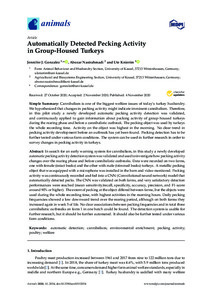| dc.date.accessioned | 2020-12-23T06:53:30Z | |
| dc.date.available | 2020-12-23T06:53:30Z | |
| dc.date.issued | 2020-11-04 | |
| dc.identifier | doi:10.17170/kobra-202012222886 | |
| dc.identifier.uri | http://hdl.handle.net/123456789/12364 | |
| dc.description.sponsorship | Gefördert durch den Publikationsfonds der Universität Kassel | ger |
| dc.language.iso | eng | eng |
| dc.rights | Namensnennung 4.0 International | * |
| dc.rights.uri | http://creativecommons.org/licenses/by/4.0/ | * |
| dc.subject | automatic detection | eng |
| dc.subject | cannibalism | eng |
| dc.subject | environmental enrichment | eng |
| dc.subject | pecking activity | eng |
| dc.subject | poultry | eng |
| dc.subject | welfare | eng |
| dc.subject.ddc | 590 | |
| dc.subject.ddc | 630 | |
| dc.title | Automatically Detected Pecking Activity in Group-Housed Turkeys | eng |
| dc.type | Aufsatz | |
| dcterms.abstract | Simple Summary
Cannibalism is one of the biggest welfare issues of today’s turkey husbandry. We hypothesized that changes in pecking activity might indicate imminent cannibalism. Therefore, in this pilot study a newly developed automatic pecking activity detection was validated, and continuously applied to gain information about pecking activity of group-housed turkeys during the rearing phase and before a cannibalistic outbreak. The pecking object was used by turkeys the whole recording time. Activity on the object was highest in the morning. No clear trend in pecking activity development before an outbreak has yet been found. Pecking detection has to be further tested under various farm conditions. The system can be used in further research in order to survey changes in pecking activity in turkeys.
Abstract
In search for an early warning system for cannibalism, in this study a newly developed automatic pecking activity detection system was validated and used to investigate how pecking activity changes over the rearing phase and before cannibalistic outbreaks. Data were recorded on two farms, one with female (intact beaks) and the other with male (trimmed beaks) turkeys. A metallic pecking object that was equipped with a microphone was installed in the barn and video monitored. Pecking activity was continuously recorded and fed into a CNN (Convolutional neural network) model that automatically detected pecks. The CNN was validated on both farms, and very satisfactory detection performances were reached (mean sensitivity/recall, specificity, accuracy, precision, and F1-score around 90% or higher). The extent of pecking at the object differed between farms, but the objects were used during the whole recording time, with highest activities in the morning hours. Daily pecking frequencies showed a low downward trend over the rearing period, although on both farms they increased again in week 5 of life. No clear associations between pecking frequencies and in total three cannibalistic outbreaks on farm 1 in one batch could be found. The detection system is usable for further research, but it should be further automated. It should also be further tested under various farm conditions. | eng |
| dcterms.accessRights | open access | |
| dcterms.creator | Gonzalez, Jennifer J. | |
| dcterms.creator | Nasirahmadi, Abozar | |
| dcterms.creator | Knierim, Ute | |
| dc.relation.doi | doi:10.3390/ani10112034 | |
| dc.subject.swd | Erkennung | ger |
| dc.subject.swd | Automation | ger |
| dc.subject.swd | Kannibalismus | ger |
| dc.subject.swd | Picken | ger |
| dc.subject.swd | Geflügel | ger |
| dc.subject.swd | Wohlbefinden | ger |
| dc.type.version | publishedVersion | |
| dcterms.source.identifier | EISSN 2076-2615 | |
| dcterms.source.issue | Issue 11 | |
| dcterms.source.journal | Animals | eng |
| dcterms.source.volume | Volume 10 | |
| kup.iskup | false | |
| dcterms.source.articlenumber | 2034 | |


